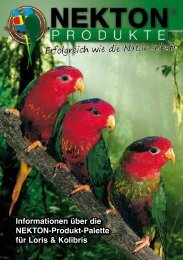You also want an ePaper? Increase the reach of your titles
YUMPU automatically turns print PDFs into web optimized ePapers that Google loves.
LORIES - LORIIDAE<br />
„The Brush-Tongued Parrots“<br />
Lories are perhaps the most beautiful of all<br />
the psittacines. Their dazzling and varied<br />
colours certainly rank them as something<br />
special in the parrot world.<br />
This group of parrots covers more than 55<br />
species and about 125 subspecies and is<br />
distributed entirely in the Pacific region in and<br />
around Australia. All sizes from small and<br />
dainty to medium (30cm) are represented in<br />
the Loriidae family.<br />
Not all the species are to be found in the tropical<br />
rain forests and lowlands as one might<br />
imagine. Many of them live in cultivated<br />
areas, mangrove swamps and the wide timberlands<br />
of Australia. Some of the species of<br />
New Guinea such as the Musschenbroek‘s<br />
or Goldie‘s Lorikeet live in the mountain<br />
regions there up to 2000m above sea level<br />
where the temperature regularly drops to<br />
zero and below at night. Even the Rainbow<br />
Lories in the subtropical areas of Australia<br />
occasionally meet with Jack Frost at night,<br />
whereas other species, particularly those of<br />
the oceanic islands, are true children of the<br />
tropics.<br />
At certain times of the year lories congregate<br />
in huge flocks, either where or in search of<br />
wherever trees and bushes are flowering to<br />
give them their particular food. This ”invasion”<br />
is often made up of several different species<br />
of lories that nevertheless live in harmony,<br />
sharing the food ”reserves” and moving<br />
off together to another area once they have<br />
consumed all the available pollen, nectar<br />
and even the blossoms. Often the ground<br />
below is carpeted with pieces of torn flowers.<br />
This does not indicate a destructive nature,<br />
however, but is all part of their natural feeding<br />
habits. This is the best way for the birds<br />
to reach the staple part of their diet – pollen.<br />
The whole alimentary canal of the lory from<br />
the narrow beak and brush-like tongue to<br />
the elementary stomach and short intestine<br />
is designed to deal with an energy-rich diet<br />
poor in bulk.<br />
Characteristics<br />
Just as lories and lorikeets come in a rainbow<br />
of colours and a variety of sizes, they<br />
can differ tremendously in behaviour. Some<br />
are tame, affectionate and learn to talk easily,<br />
others are aggressive, nervous and easily<br />
excited. All are extremely active and most of<br />
them are very playful and entertaining. They<br />
love to take a bath or lie on their backs with<br />
their feet up in the air playing with a toy or<br />
a piece of food. This supine position is also<br />
taken in defence, and the lory uses its strong<br />
beak and sharp claws to repulse attacks. As<br />
a group they are lively, intelligent and good<br />
talkers but they have strong personalities<br />
and are great individualists.<br />
Unfortunately the „Lori-speak“ of loud screams<br />
and harsh voices is not to everyone’s<br />
taste, and the strong smell off some species<br />
often detracts from the pleasure of keeping a<br />
lory or lorikeet as a companion bird as well.<br />
Accommodation and Care<br />
Because of the messy droppings (the main<br />
deterrent) and their love of splashing around<br />
in water these birds are not really suited to an<br />
indoor life. They are best kept in a large wellplanted<br />
aviary with a heated shelter for the<br />
winter. The aviary should also be equipped<br />
with a roosting and a nest-box with different<br />
sized openings and a large flat dish of water<br />
for bathing.<br />
Lories need 12 hours of daylight a day and<br />
a drop in temperature at night to reconstruct<br />
their equatorial origins.<br />
Keep their entire living, playing and nesting<br />
area clean, dry and germ-free and lories will<br />
reward you with good health and playful companionship.<br />
The birds should also be examined regularly<br />
for mites and other skin parasites.<br />
Breeding<br />
If not already known, it will be difficult to<br />
determine a true pair yourself for breeding as<br />
both sexes are very similar in appearance.



